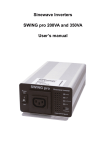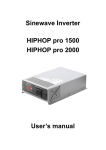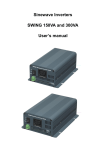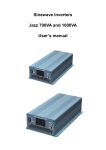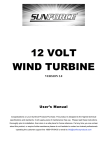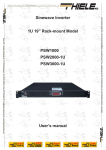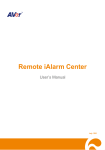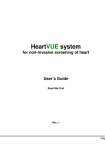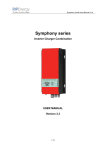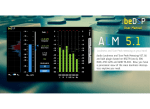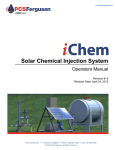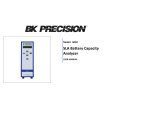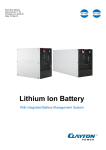Download Battery Charger Series EASY Charger User`s manual
Transcript
Battery Charger Series EASY Charger User’s manual 1 Warranty RIPEnergy is not manufacturer of these units. All technical information’s, data’s and dimensions rely on information’s given by the manufacturer. Therefore RIPEnergy AG is not responsible for the data’s provided in this manual. Should work take place, which is not in accordance with guidelines, local rules, instructions or specification’s, damage may occur. All of these matters will lead to loss of warranty. RIPEnergy AG can not accept any liability for damages or costs arising due to the use of these chargers. 2 Distributor’s address RIPEnergy AG, Talstrasse 2, CH-8702 Zollikon, Schweiz Tel : ++41-(0)43-818 53 85 Fax : ++41-(0)43-818 53 87 Email: [email protected] Internet: www.RIPEnergy.ch Manual EASY Charger V2.doc 2/12 Version 2 Contents 1 2 3 4 5 6 7 8 9 10 Warranty ..................................................................................................................................... 2 Distributor’s address ................................................................................................................... 2 General Information .................................................................................................................... 4 Use of this manual ...................................................................................................................... 4 Limitation of liability..................................................................................................................... 4 Warranty specifications (short form) ........................................................................................... 4 Unpacking ................................................................................................................................... 5 Environmental protection ............................................................................................................ 5 Description of the charger........................................................................................................... 5 Safety Information....................................................................................................................... 6 10.1 General information ........................................................................................................... 6 10.2 Working with batteries ....................................................................................................... 6 11 Planning and mounting the charger............................................................................................ 7 11.1 Required power draw ........................................................................................................ 7 11.2 Installation ......................................................................................................................... 7 11.3 Wiring ................................................................................................................................ 7 12 Operation .................................................................................................................................... 8 12.1 Engaging ........................................................................................................................... 8 12.2 Maximum Charge Current ................................................................................................. 8 12.3 Dual Bank Mode Model 1230 only .................................................................................... 8 12.4 Power down....................................................................................................................... 8 13 Display ........................................................................................................................................ 8 13.1 Status LED ........................................................................................................................ 8 13.2 LCD Meter Models Version “M” only ................................................................................. 8 13.3 Digital Meter Models Version “D” only............................................................................... 9 14 Maintenance ............................................................................................................................. 10 15 Further assistance and sending the unit for repair ................................................................... 10 16 Technical data........................................................................................................................... 11 Manual EASY Charger V2.doc 3/12 Version 2 3 General Information Thank you for choosing a product supplied by RIPEnergy AG. The product you have bought is manufactured to meet the highest quality standards. 4 Use of this manual This user’s manual contains the information you need to install and operate this charger correctly. Check that you have the correct manual for your unit. It is valid for the following units: Battery chargers Series EASY Charge Read the manual carefully before installing or operating the charger. If you do not understand or are uncertain about any operation or information, please contact your dealer. The user must always have access to the user’s manual. The latest version of the manual is provided and can be downloaded from the homepage of RIPEnergy AG. These chargers must be only installed by qualified, authorized and trained personnel familiar with the locally applicable standards and taking into consideration all relevant safety guidelines and measures! Modifications or breaking the warranty label without a written permission from RIPEnergy AG means that warranty is lost immediately! Always contact your dealer first if you have any problems. 5 Limitation of liability RIPEnergy AG is not responsible or liable for any loss, damage or costs arising from operating these chargers. The products supplied by RIPEnergy AG are not for applications in any medical equipment intended for use as a component of any life support system. If products are used in such systems, a specific written agreement between the manufacturer, RIPEnergy AG and the installer/manufacturer of the system is needed. In addition, the manufacturer of the system must agree to indemnify RIPEnergy AG from any claims arising from use of products supplied by RIPEnergy AG in the life support equipment. 6 Warranty specifications (short form) The chargers are built for RIPEnergy AG in according to the legally applicable standards. During production, and prior to delivery, all products are tested and inspected. RIPEnergy AG is looking to find the best available products on the market. Good quality parts and the latest technology of the units will ensure a long lasting and trouble free operation of these units. If any problem occurs during warranty period, please contact your dealer first. He is able to serve you with instructions and explains you how to send the unit to the nearest service center, if necessary. Warranty can only be guaranteed if you enclose a document (Invoice or delivery documents) to the defective units. Manual EASY Charger V2.doc 4/12 Version 2 Damage attributable to normal wear and tear, overload or improper handling or installation is not covered by the warranty. Modifications or breaking the warranty label without a written permission from RIPEnergy AG means that the warranty is lost immediately! Always return the units in the original package and completely assembled. A short description of the failure/problem will help us to serve you better (see also instructions on item 17). RIPEnergy AG is not paying for costs arising for transport of the unit or damage that arises during the time the unit is unserviceable. The general terms of delivery and terms of sale of RIPEnergy AG are valid. 7 Unpacking After unpacking, carefully check the unit for possible damage. If any damage due to transport is visible immediately contact your dealer for further instructions. Keep the original packing in case you need it to transport the unit later. 8 Environmental protection RIPEnergy AG continually commits a considerable part of its resources towards minimizing the environmental impact of its products. The product is manufactured with valuable materials and easy to recycle. 9 Description of the charger These models are 3-stage battery chargers for smaller sized service batteries, featuring the latest high frequency switching mode technology. A micro controller circuitry provides intelligent battery management, reliable operation and high efficient charging. Manual EASY Charger V2.doc 5/12 Version 2 10 Safety Information 10.1 General information If you do not understand or are uncertain about any operation or information please contact your dealer. Before installation you must be aware of local standards and rules applicable to use such equipment. For installation and use of the unit pay attention to local applicable standards, all relevant safety guidelines and measures. These rules may be different to the information’s provided in this manual. High voltages up to 1000V inside the charger! Never open the enclosure. High voltage may harm or even kill persons or animals. Never touch wires or blank connectors. Do not operate the charger with damaged or substandard wiring. Check local standards for lightning protection of charger systems. The enclosure may heat up to 60°C! Never obstruct louvers nor place other items on the chargers enclosure. If ventilation is not sufficient the unit may overheat and an automatic shut off may occur. The charger contains components which can produce arks and sparks. Never use or operate the unit where there is danger of gas- or dust explosion. After automatic shut down of the charger because of any failure the charger may switch ON automatic again. The OFF period is depending on what causes the shut down and may vary from only seconds to several minutes. 10.2 Working with batteries Using batteries in a wrong way may result in danger for personnel, animals or the environment. Check information from battery manufacturer for safe installation and operation. If battery acid contacts skin or clothing, wash immediately with soap and water. If acid contacts eyes, immediately flush with running cold water for at least 20 minutes and get medical attention as soon as possible. Never smoke or allow a spark or flame in vicinity of batteries. Do not drop metal tools on batteries. The resulting spark or short circuit may cause an explosion. Remove personal metal items such as rings, bracelets, necklaces and watches when working with batteries. Manual EASY Charger V2.doc 6/12 Version 2 11 Planning and mounting the charger This section will provide you information’s about configuring and installing your charger. Make sure that you are aware of local rules and safety measurements. 11.1 Required power draw Before connecting your batteries to the charger, always check the required charge current and voltage. As a rule of thumb the charge current should reach about 10% of battery capacity. If your battery has a capacity of 100Ah a charge current of 10A is perfect. The charger is protected against overload and short circuit. It will switch off automatically when overload is applied. As ambient temperature is above 20°C the chargers nominal power may be smaller due to reduced cooling. Using the charger in high altitudes may also reduce nominal power of the charger because of less heat discharge. As a rule of thumb, the reduction of nominal power is approximately 1.5% per 100m elevation. 11.2 Installation These units must be only installed by qualified, authorized and trained personnel familiar with the locally applicable standards and taking into consideration all relevant safety guidelines and measures! Before installing the unit check for correct DC-Voltage and power level of the charger. The Charger may be installed in any position. Install the charger in a dry, well ventilated and dust free location. It must be installed out of reach for unauthorized personnel especially children’s. Do not install the charger in the same compartment as the batteries. Never use or install the charger in locations where there is gas or explosive danger! For proper cooling of the Charger ensure that the airflow is not obstructed and keep a clearance distance of 2.5cm to other units. If the charger is installed in a closed compartment the nominal power may be reduced. In order to keep the battery cables as short as possible (max. 3m) locate the charger close to the DCDistribution or battery. Be aware that during charging of batteries an explosive gas can be generated. 11.3 Wiring Position of the switch on the front panel must be OFF. Caution! First connect the assembled DC-Cables with the battery. Always connect first the negative wire (black) with the battery! Red = positive (+) Black = negative (-) In a second step connect it with the mains power. The charger must be plugged-in to an earthed socket outlet. The way of wiring has influence on the EMC behaviour of the system. Most problems using charger are because of unprofessional wiring. If problems occur, lay the DC-cables in a metal duct. If this is not possible the cables should be twisted and lay parallel to a metal bar. To thin cable or loose connections can cause dangerous overheating of cables or terminals. Always use DC cables of the correct size to avoid fire and other damage. If you connect other consumers to the battery contact your dealer. Manual EASY Charger V2.doc 7/12 Version 2 12 Operation The charger is controlled by a single two position switch located on the front or rear panel of the charger. 12.1 Engaging Switch to “ON-Position“. The red LED will illuminate. The charger is ready to use. 12.2 Maximum Charge Current Note: The max. Charge current may not be reached when the battery is old and worn out. It is also reduced during absorption and float mode (see graph above). 12.3 Dual Bank Mode Model 1230 only This model is able to charge two independent battery banks at the same time. The charge current is automatically splitted between the two DC-Outputs. 12.4 Power down Switch to „OFF-Position“. The LED’s are dark. The charger output is OFF. The charger may be connected to the battery at all times. Warning! Do not charge non-rechargeable batteries! 13 Display 13.1 Status LED Red LED ............................................................................................................................... Power ON Steady yellow .......................................................Fast charge mode, bulk and absorption/ equalizing Steady green .................................................................................. Float charge mode, battery is full. 13.2 LCD Meter Models Version “M” only The LCD Display shows actual charge status: Bulk/Equalize Charge or Float Charge. It also indicates the approx. Battery Level: 25%, 50%, 75% and 100% Manual EASY Charger V2.doc 8/12 Version 2 13.3 Digital Meter Models Version “D” only Digital Meter / Timer programming U - Output-/Battery voltage Vdc A - Charge current Adc P - Battery charge level in % H - Capacity recharged in Ah (Ampere hour) The Ah calculation starts, when charge current is >1A. To reset Ah counter (set it to zero) – press button for 3 seconds. h - Charging time in hours It shows the total charging time since the Ah calculation has started. If Ah counter is set to zero, the time will be reseted to zero. t - Elapsed time of timer operation in hours This time is only displayed when the timer has been triggered automatically. E - Timer programmed in hours If charge current drops below 30% of nominal charge current, the timer starts. The charger is changing to true float mode (stage 3) when the time has lapsed. Programming the timer The time can be programmed in 0.1hour steps from 0.1h up to 6h. - Press the button for approx. 5 seconds Decreasing time if lower display segment is blinking Increasing time if upper display segment is blinking (change it lower/upper by pressing the button for 2 seconds) - If the desired time is set, press the button for approx. 5 seconds to store this new value. What is this function for? By adding this function, the charger is able to limit equalize charging (stage 2) time of the battery. This function will enable longer battery life time when charging a large battery. If you charge a large battery with small current, the chare current never drops below 10% of nominal charge current and the charger will not change to float mode but remain in equalize mode (stage 2). This can result in excessive use of water or damage of the battery (GEL type). Overvoltage If battery voltage is above maximum allowed voltage (this may happen if batteries are charged by solar- or other generator). A new charge cycle will automatic start, if voltage is within normal voltage range. Manual EASY Charger V2.doc 9/12 Version 2 14 Maintenance Only little maintenance is required to keep your charger and system operating reliable. The charger must be switched off during maintenance and/or repair activities. It also must be secured against unexpected and unintentional switching on. Therefore switch off the connection between batteries and charger and be sure that third parties cannot reverse the measures taken. The following Steps must be undertaken at least once a year. Check cable and wires for damage and if they are still firmly connected. Defects such as loose connections ore damaged cables etc. must be corrected immediately. Keep the charger dry, clean it from dust in order to ensure good heat discharge. 15 Further assistance and sending the unit for repair In the rare case the unit is not working, contact your dealer providing him some details as: 1. Check Battery voltage, wiring and display for possible failures. 2. Note: Type of unit and serial number. 3. Now call your dealer or nearest service center. They will help you with further instructions. 4. If he recommends to send the unit back for repair, use the original packing. Include a copy of the invoice (Warranty repair is only possible with a copy of invoice or certificate showing date of purchase) and a short notice about your system and the failure observed. 5. In case you have to send the unit over state borders please make sure to fill the correct papers needed for customs. To reduce time and save money, contact the consignee how to declare the delivery. Arising costs for customs have to be paid by the sender. 6. Transport costs to send the unit back to RIPEnergy AG are not covered from Warranty. Manual EASY Charger V2.doc 10/12 Version 2 16 Technical data Manual EASY Charger V2.doc 11/12 Version 2 (Specifications Subject to Change without Notice) Manual EASY Charger V2.doc 12/12 Version 2












